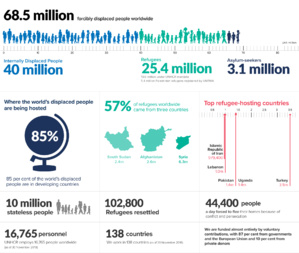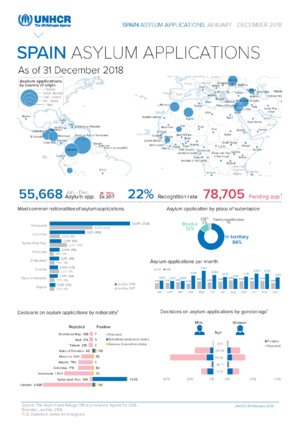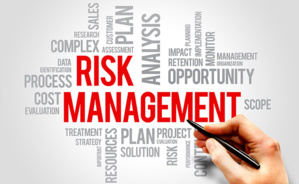As per UNHCR's recent report, we are now witnessing the highest levels of displacement on record. An unprecedented 68.5 million people around the world have been forced from home. Among them are nearly 25.4 million refugees, over half of whom are under the age of 18.
There are also an estimated 10 million stateless people who have been denied a nationality and access to basic rights such as education, healthcare, employment and freedom of movement.
In a world where nearly 1 person is forcibly displaced every two seconds as a result of conflict or persecution, our work at UNHCR is more important than ever before.
Emergency: Europe situation.
In the first half of 2017, over 105,000 refugees and migrants entered Europe. This movement towards Europe continues to take a devastating toll on human life. Since the beginning of 2017, over 2,700 people are believed to have died or gone missing while crossing the Mediterranean Sea to reach Europe, with reports of many others perishing en route. These risks do not end once in Europe. Those moving onwards irregularly have reported numerous types of abuse, including being pushed back across borders.
With so many lives at risk, rescue-at-sea operations undertaken by all actors must remain a priority. Despite some progress in increasing the number of safe pathways to Europe, these opportunities are far too few to offer a feasible alternative to risky irregular journeys for people in need of protection. Further efforts are needed to increase access to existing legal pathways, including family reunification.
UNHCR also calls for European and other countries to offer an additional 40,000 resettlement places, which will complement already existing commitments, to be made available for refugees located in 15 priority countries along the Central Mediterranean route.
Those arriving in Europe need adequate reception and assistance, particularly those with specific needs, including unaccompanied and separated children and survivors of sexual and gender based violence, and access to fair and efficient asylum procedures. More solidarity is needed within the EU to ensure protection, including through efficient and speedy family reunion and relocation.
Overall, there is a need for a comprehensive plan of action that will support long-term solutions to the complex issue of mixed migration and help address its root causes, in close cooperation with countries of origin and transit and in line with international law.
In the first half of 2017, over 105,000 refugees and migrants entered Europe. This movement towards Europe continues to take a devastating toll on human life. Since the beginning of 2017, over 2,700 people are believed to have died or gone missing while crossing the Mediterranean Sea to reach Europe, with reports of many others perishing en route. These risks do not end once in Europe. Those moving onwards irregularly have reported numerous types of abuse, including being pushed back across borders.
With so many lives at risk, rescue-at-sea operations undertaken by all actors must remain a priority. Despite some progress in increasing the number of safe pathways to Europe, these opportunities are far too few to offer a feasible alternative to risky irregular journeys for people in need of protection. Further efforts are needed to increase access to existing legal pathways, including family reunification.
UNHCR also calls for European and other countries to offer an additional 40,000 resettlement places, which will complement already existing commitments, to be made available for refugees located in 15 priority countries along the Central Mediterranean route.
Those arriving in Europe need adequate reception and assistance, particularly those with specific needs, including unaccompanied and separated children and survivors of sexual and gender based violence, and access to fair and efficient asylum procedures. More solidarity is needed within the EU to ensure protection, including through efficient and speedy family reunion and relocation.
Overall, there is a need for a comprehensive plan of action that will support long-term solutions to the complex issue of mixed migration and help address its root causes, in close cooperation with countries of origin and transit and in line with international law.
Persecution, conflicts and human rights violations continue to force people to flee their homes and seek safety in Europe. Many risk their lives and face a treacherous journey.
>Total arrivals
12,349
Last updated 12 Mar 2019
>Sea arrivals in 2019 (includes refugees and migrants arriving by sea to Italy, Cyprus, Greece, Malta and Spain)
9,773
Last updated 12 Mar 2019
>Land arrivals in 2019 (includes refugees and migrants arriving by land to Greece and Spain)
2,576
Last updated 28 Feb 2019
>Dead and missing in 2019 (estimate)
226
Last updated 12 Mar 2019
More statistics
Locations x3: Italy, Greece, and Spain
Updated 6 December 2018
>Total arrivals
12,349
Last updated 12 Mar 2019
>Sea arrivals in 2019 (includes refugees and migrants arriving by sea to Italy, Cyprus, Greece, Malta and Spain)
9,773
Last updated 12 Mar 2019
>Land arrivals in 2019 (includes refugees and migrants arriving by land to Greece and Spain)
2,576
Last updated 28 Feb 2019
>Dead and missing in 2019 (estimate)
226
Last updated 12 Mar 2019
More statistics
Locations x3: Italy, Greece, and Spain
Updated 6 December 2018
What is UNHCR doing to help?
UNHCR, working with partners, is providing a broad range of support and assistance in Europe for refugees and asylum-seekers. These efforts include humanitarian and cash assistance, provision of accommodation and support to improve reception conditions, prevention and response to sexual and gender-based violence, protection monitoring and interventions, engaging with refugee communities to enhance their participation and including their voice in their voice in the response, identification and support to persons with specific needs, including separated and unaccompanied children, and referral to appropriate services.
To adequately respond to the protection needs of refugees and migrants arriving in Europe, UNHCR launched the regional Refugee and Migrant Response Plan (RRMP), involving 60 partners.
To improve the situation of refugee and migrant children arriving and staying in Europe without their parents or care givers, UNHCR, UNICEF and IRC issued a Roadmap and a call to action (1).
UNHCR has sets out a practical vision for the EU’s global engagement with refugees and for the reform of its asylum system in its paper “Better Protecting Refugees in the EU and Globally”.
---
(1) Kindly check "Europe: new Roadmap to improve the situation of unaccompanied and separated refugee and migrant children.", Joint UNHCR/UNICEF/IRC Press Release, July 2017.
UNHCR, working with partners, is providing a broad range of support and assistance in Europe for refugees and asylum-seekers. These efforts include humanitarian and cash assistance, provision of accommodation and support to improve reception conditions, prevention and response to sexual and gender-based violence, protection monitoring and interventions, engaging with refugee communities to enhance their participation and including their voice in their voice in the response, identification and support to persons with specific needs, including separated and unaccompanied children, and referral to appropriate services.
To adequately respond to the protection needs of refugees and migrants arriving in Europe, UNHCR launched the regional Refugee and Migrant Response Plan (RRMP), involving 60 partners.
To improve the situation of refugee and migrant children arriving and staying in Europe without their parents or care givers, UNHCR, UNICEF and IRC issued a Roadmap and a call to action (1).
UNHCR has sets out a practical vision for the EU’s global engagement with refugees and for the reform of its asylum system in its paper “Better Protecting Refugees in the EU and Globally”.
---
(1) Kindly check "Europe: new Roadmap to improve the situation of unaccompanied and separated refugee and migrant children.", Joint UNHCR/UNICEF/IRC Press Release, July 2017.
Tags :
EU emergency on global displacement
Global displacement
Refugee and Migrant Response Plan (RRMP)
refugees and asylum-seekers
UNHCR
Posted by Christopher Oscar de Andrés, on Thursday, March 14th 2019 at 07:25
|
Comments (0)
There are five (5) main styles of conflict resolution:
- COMPETING IS ASSERTIVE AND UNCOOPERATIVE
- ACCOMMODATING IS UNASSERTIVE AND COOPERATIVE
- AVOIDING IS UNASSERTIVE AND UNCOOPERATIVE
- COLLABORATING IS BOTH ASSERTIVE AND COOPERATIVE
- COMPROMISING IS MODERATE IN BOTH ASSERTIVENESS AND COOPERATION
It is convenient we focus on the most successful approach, which usually happens to be a ‘collaborative solution’, since it also translates to a win-win action. To arrive to such approach it is vital to get to the facts. We need to allow our team to embrace concrete neutral pieces of information and separate the facts from emotion/s.
Keeping to facts and measurable data: if individuals stay with facts and measurable data, it is rather difficult to dispute an opinion. Guiding the answers to facts and measurable data will allow us to gather information that can aide to move from position to interests.
Below we list the pre-stages that we must go through:
a) We sight for a collaborative solution
b) We work together
c) We listen to everybody's points of interest, moving our focus from position to interest
d) We are now at the end where a decision is being made.
It should be emphasized: separating the emotion out of it and establishing the core issues with respect to the facts that are involved in the resolution process.
Keeping to facts and measurable data: if individuals stay with facts and measurable data, it is rather difficult to dispute an opinion. Guiding the answers to facts and measurable data will allow us to gather information that can aide to move from position to interests.
Below we list the pre-stages that we must go through:
a) We sight for a collaborative solution
b) We work together
c) We listen to everybody's points of interest, moving our focus from position to interest
d) We are now at the end where a decision is being made.
It should be emphasized: separating the emotion out of it and establishing the core issues with respect to the facts that are involved in the resolution process.
Moreover, it is relevant to assess:
-Who are the actors involved and who do they represent?;
-Is there any past history linked to the conflict? If so, we need to identify what the core issues are;
-We must identify if it is negotiable: are these core issues something that can be worked on?;
-Are there any common interests? How our team can work together to get to an achieved goal?;
-What values we have with respect to conflict? There could be certain core values that do not allow them to move forward to transform the situation - i.e. core values individual currently have which are not in line with the institution’s mandate and corporate values.
Resolution stages:
a) Apply active listening skills when dealing with conflict
b) Recognize conflict and know when to intervene
c) Review the five approaches to conflict (above) and establish a sustainable channel
d) Create an effective action plan and most importantly, produce an agreed upon solution.
-Who are the actors involved and who do they represent?;
-Is there any past history linked to the conflict? If so, we need to identify what the core issues are;
-We must identify if it is negotiable: are these core issues something that can be worked on?;
-Are there any common interests? How our team can work together to get to an achieved goal?;
-What values we have with respect to conflict? There could be certain core values that do not allow them to move forward to transform the situation - i.e. core values individual currently have which are not in line with the institution’s mandate and corporate values.
Resolution stages:
a) Apply active listening skills when dealing with conflict
b) Recognize conflict and know when to intervene
c) Review the five approaches to conflict (above) and establish a sustainable channel
d) Create an effective action plan and most importantly, produce an agreed upon solution.
In the context of conflict situations, related to middle size teams, individuals tend to emotionalize a particular position, which generates some obstacles in the process to try to seek a resolution and move through the resolution stages. Once we reach the interest level, which is aligned with what our total objectives are, our team should be able to separate the two -interests and objectives- in order to identify the interest/s in the conflict scenario, we are also on an advanced step of resolution.
Many people want to focus on the reasons why a solution cannot be reached versus to try to explore the reasons why it can be possible. It is a ‘comfort zone’ people get into. They have their position that they have decided to take. Therefore, they tend to shelter and protect themselves from anything that might suggest a different alternative approach. Before we take a final decision -a final call of action- we are going to be required to provide every member of the team a recap of what was developed across each one of the resolution stages.
Furthermore, we should deal with making an effort to get to every individual to share with us, not only what the issue is, but how they would resolve it. Here we find the final resolution step: design the action plan.
Many people want to focus on the reasons why a solution cannot be reached versus to try to explore the reasons why it can be possible. It is a ‘comfort zone’ people get into. They have their position that they have decided to take. Therefore, they tend to shelter and protect themselves from anything that might suggest a different alternative approach. Before we take a final decision -a final call of action- we are going to be required to provide every member of the team a recap of what was developed across each one of the resolution stages.
Furthermore, we should deal with making an effort to get to every individual to share with us, not only what the issue is, but how they would resolve it. Here we find the final resolution step: design the action plan.
Category
Recent posts
Archives
10-N
ACNUR
ADHESIÓN DE CROACIA A LA UE
Africa
Agenda 2020 en España
Airbus A320 passengers
Al Jazeera
Amnistía Internacional
Ana Pastor
Angela Merkel
Ant Financial
Ant’s QR-based Health Code System
AnálisisyGestiónInteligenteDeDatos
Asamblea General de Naciones Unidas
Autor Christopher O de Andrés
Autoridad del Canal de Panamá (ACP)
Año Nuevo chino 2017 - el año del Gallo Rojo de Fuego
Boris Johnson
Brexit
Cabify
Caixabank
Calculated risks
Canal de Panamá
CE
CEMEX Mexico
CEN
CENELEC
China
CIA major internal investigation
Comisión Europea
Coronavirus
COVID-19
Covid-19
COVID19
CRISIS FINANCIERA
Cybercrime
David Cameron
Editorial Universitas SA
EU Convention of Human Rights
European Commission
FMI
Henrique Capriles
Human Rights
ICAA
International Business Development
Jack Ma
Jean-Claude Juncker
Mariano Rajoy
Obama
ONU
OSCE
The Council of Europe
Thomas Hammarberg
UNED
UNHCR
Unión Europea
Vladímir Putin










